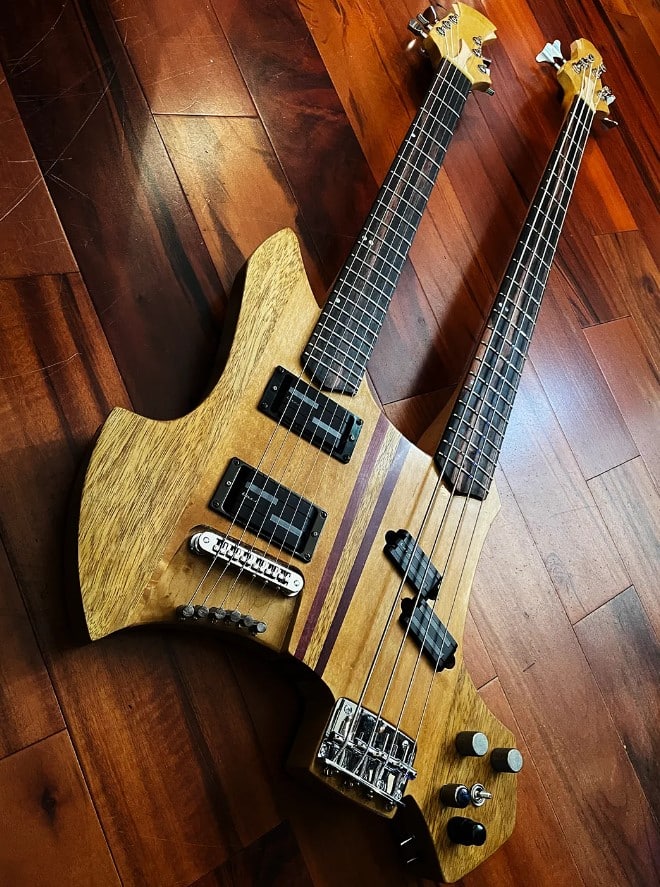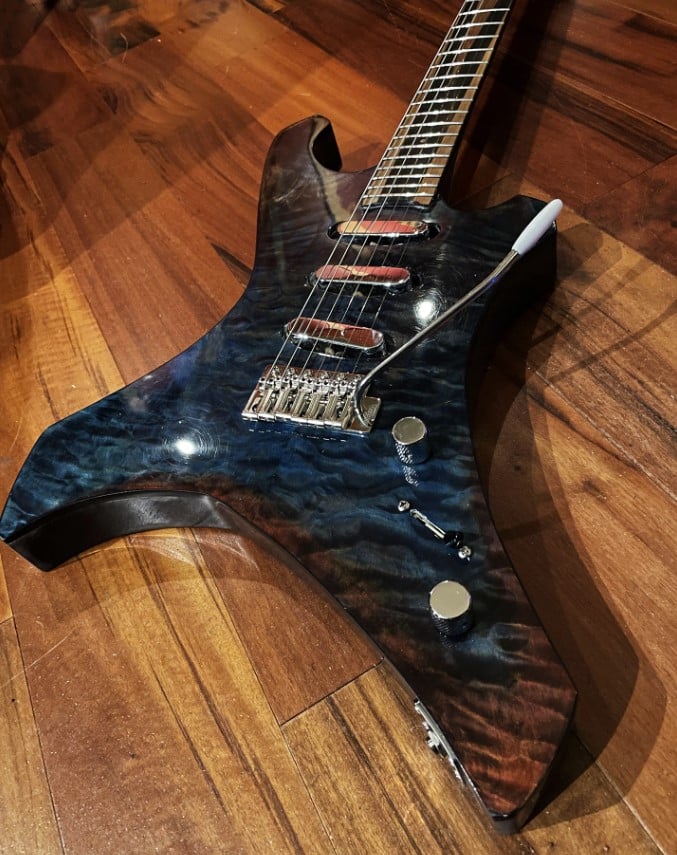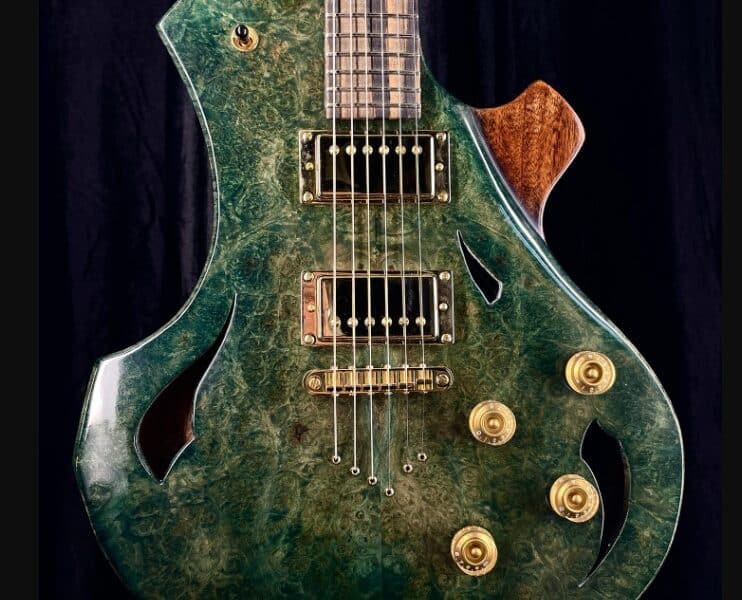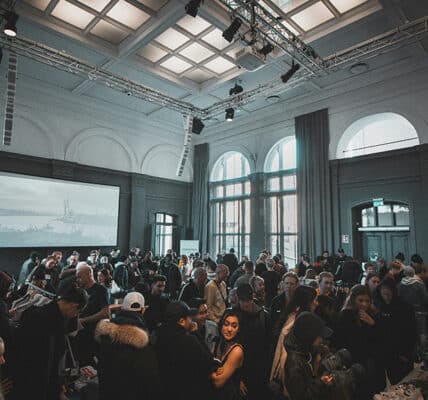
Kent Meloy, founder and designer of Tunguska Guitars, began building his first official piece back in 2015. It was a custom, scratch built design, and it would solidify his love of lutherie and start a company of pretty epic designs. You’ve never seen guitars like these. What began as a hobby had turned into a passion that would lead to a heartfelt career.
Being a fan of more non-traditional body styles, Kent decided his company would specialize in unique instruments. He’s joined by Mark Szabo, who works on the electronics and custom pickups. Together, they’ve created a successful enterprise and even folding in an offshoot of the speciality; taking old and forsaken guitars and bringing them back to life. They have a YouTube channel where they show the process of various builds and solve problems. (His first career was teaching film at the University of Cincinnati, which would come in handy later for marketing and YouTube.)
Kent began playing around with guitar builds in the early 80s, taking a long break after concocting an instrumental experiment that in his own words “ gave one the distinct
feel of playing a 2×4”. He decided to try again in 2013, practicing and refining his skills for the next two years. His love for building intensified as the designs flowed like water. He would refine his credentials and the quality of his craft until finally making the decision to turn it into a legitimate business—letting go of his job as a professor to start building full time.
Following is an interesting conversation with Kent about his builds and how his new dream is “finding its legs”.
Where does the drive to experiment and invent come from for you? Is there anything in particular that drives that passion?
For good or ill, I’ve always been this way, I see things and go “I wonder if I could make my own take on that?”. Even when I was a kid I wasn’t just satisfied watching Star Trek or Speed Racer (my first two media obsessions); I had to try to come up with my own versions. I’ve got some horrifically bad stories I wrote in the early 70’s somewhere to prove it. It’s also been a blessing (curse?).

Since I was first learning to play guitar, I was more interested in trying to write my own stuff than learning covers. Kinda became a problem when folks wanted to jam to the standard rock guitar songs in bands over the years. Ah well. I don’t know – maybe it’s a glitch in my ego? I’m always wanting to take what’s already been done, look at it from another angle and try something different. That and for me at least, I don’t feel that creating verbatim copies of iconic guitars is where my talents are best used. I suppose the downside to that is it makes it a little bit more of a hard sell since guitarists have been using Les Pauls and Strats and SGs and Teles as the undeniable workhorse champions of guitar-driven music for as long as I’ve been alive.
But even then, I’ve always been drawn to the oddballs. I love me an Explorer or an Iceman – a Parker Fly or an Ovation Deacon. One of my pride and joys is a beat-to-hell ’79 Gibson RD Custom I picked up from a friend years ago. I think also, there’s a desire to leave my mark if at all possible. With so many insanely talented builders out there, that’s a total conceit, but if I’m going to be honest with myself I have to admit there’s truth there. And I simply LOVE coming up with new things, trying them out, seeing what works and what doesn’t.
I used to be pretty quick to get cheesed off when trying to build/make/write something and the inevitable screw-ups would happen, but the past few years of building on my own design ideas have turned problems into solutions to be found, and it turns out I really love that. I also really like the puzzle-solving of taking wood that is in many ways unsuitable for a standard electric guitar and figuring out how to make it work.
My brother-in-law gave me this bonkers piece of live-edge/live-end cherry that was just not something you’d use for a solid body. So I did anyway. It involved making a custom bridge and tailpiece from bits of 3/8″ wide steel rod and heat bending each with a blow-torch to span the disintegrating valley of bark inclusion, using a steel ring to emulate a sound hole so I could hide-in-plain-sight the odd things I had to do to make the pickup mount work – stuff like that. I ended up calling it “Keefe”, ’cause it just felt like it was defying time and despite outward appearance will probably live forever. Just like its namesake. 🙂
Do you have any favorite pickups or amps complementing your guitar designs?
Yes! The first four guitars I built once I decided to start taking this seriously were equipped with Lace Alumitones. I was first drawn to them due to the unconventional look. I’m always trying to weave a subtle art-deco vibe into my designs, and they absolutely fit the bill. They also sound amazing, which certainly helped. However, when Mark Szabo (my partner-in-crime) came into the fold, he had already been messing around with his own pickup designs and had wound a bunch for his own guitars and a few clients. He suggested we should start equipping our builds with these custom pickups, and I love them!!! He has been experimenting with different magnets (we have a couple sets of Alnico 3 based pickups that sound bonkers good). It’s also allowing us to really make these guitars versatile between the pickups and electronics configurations: dialing in the combo of magnets, number of winds, and control switching options that give the best balance and breadth of desired tone.

Mark’s got this massive spreadsheet of every pickup he’s made – S vs. HB, type of magnets, number of winds, notes on tone when installed, etc. Very cool stuff. Amp-wise, I personally have a couple of faves. One is Mark’s Marshall SV20H, which sounds amazing. Another is my Bugera Vintage V22 that I picked up ’cause I needed a lower-watt amp for gigging and I was tired of lugging around monsters. I’ve owned a lot of amps over the years, but this is by far my favorite, and I love how our guitars sound through it. I’ve heard our instruments played through all sorts of different amps, and I’ve yet to hear one that makes me go ‘meh’. For example I’ve played the same guitar through a trusty vintage Fender Twin and a goofy little Vox MV50 and was quite happy with the noises made.
What’s the skinniest you’ve ever gone on a neck? I’ve got a lot of shredders in my reading audience.
Funny you should ask! We’ve actually been starting to see how skinny we can go and feel like nothing horrible will happen. The two most recent builds, the “Phoenix” that I did for last year’s Great Guitar Build Off, and the “Xanadu” that I just finished (which is a re-imagining of the very first guitar I built in shop class in 1981), both have necks that measure .790 at the first fret and about .820 at the 12th. I love how they feel, and we always use a combination of spoke-nut dual action truss rods and a pair of carbon fiber rods on either side to keep the necks nice and rigid once they’re set up. Unless a client has a specific request, that’s our standard moving forward.
How would someone get the opportunity to try out a few of your guitars?
At the moment it would be to come to us in Cincinnati! That being said, now that we’re about to pull the trigger on the LLC to make this the “Official Thing We Do For A Living”, Mark and I are talking to some boutique shops and regional guitar shows. If we can get enough instruments made, we’re hoping to get a Luthier’s Booth at next year’s NAMM show. We’ll see how that turns out. We’ll know a lot more over this summer about the wheres and whens of how folks can get their hands on one.
Do you find yourself giving a lot of guidance when someone commissions you to build a custom model?
Absolutely, especially when it’s a custom order. Every commissioned instrument so far has involved a lot of back-and-forth with the client. Color selection, pickup config and tone, neck profile – pretty much anything someone can have a preference on. Mark and I both feel if someone is going to honor us enough to spend their hard-earned money on one of our designs, they should get the exact instrument they desire. We’re even getting into some unexplored territory – the what was supposed to be a one-off curiosity of “The Mouse” – an acousti-lectric barritone solid body uke – has gotten a lot of tentative requests, so we’re sorting out how that fits into the fray. I’m also building a lap steel commission for a guy who has supplied me with 50-year-old cherry wood that was his father’s. So that’s another area where we like to work with the client – using materials that are dear to them, integrating it into what will hopefully become an heirloom instrument.
He didn’t dismiss his filmmaking background, however; you can enjoy some quality guitar building videos on that YouTube channel mentioned earlier.
Visit his website for more information, stories and photos:





